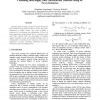201 search results - page 4 / 41 » Evaluating Run-Time Techniques for Leakage Power Reduction |
ISQED
2006
IEEE
14 years 1 months ago
2006
IEEE
As a result of aggressive technology scaling, gate leakage (gate oxide direct tunneling) has become a major component of total power dissipation. Use of dielectrics of higher perm...
ISLPED
2005
ACM
14 years 1 months ago
2005
ACM
SRAM leakage constitutes a significant portion of the standby power budget of modern SoC products for handheld applications such as PDA and cellular phones. NMOS and PMOS reverse ...
ICCD
2002
IEEE
14 years 4 months ago
2002
IEEE
Multiple supply voltages, multiple transistor thresholds and transistor sizing could be used to reduce the power dissipation of digital blocks. This paper presents a framework for...
ICPP
2009
IEEE
13 years 5 months ago
2009
IEEE
This paper evaluates several techniques to save leakage in CMP L2 caches by selectively switching off the less used lines. We primarily focus on private snoopy L2 caches. In this c...
PATMOS
2004
Springer
14 years 28 days ago
2004
Springer
Leakage power consumption of current CMOS technology is already a great challenge. ITRS projects that leakage power consumption may come to dominate total chip power consumption as...

